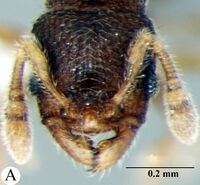Vollenhovia taylori
| Vollenhovia taylori | |
|---|---|

| |
| Scientific classification | |
| Kingdom: | Animalia |
| Phylum: | Arthropoda |
| Class: | Insecta |
| Order: | Hymenoptera |
| Family: | Formicidae |
| Subfamily: | Myrmicinae |
| Tribe: | Crematogastrini |
| Genus: | Vollenhovia |
| Species: | V. taylori |
| Binomial name | |
| Vollenhovia taylori Rilta, Dhadwal & Bharti, 2023 | |
This species was unfortunately described from a single specimen from West Bengal, India (Dhadwal et al. 2023), and the discovery of further material appears crucial to define its intraspecific variation. However, the holotype specimen of V. taylori bears some unique characteristics, including the relatively enlarged nodes (PEW/CS: 0.35; PPW/CS: 0.43) and coarse sculpture and large punctuations over the dorsal surface of the body. The most similar taxon is Vollenhovia mawrapensis, the two being both from Eastern India and very small in size, but V. mawrapensis is distinguishable based on the number of mandibular teeth, head shape, sculpture and pilosity (Akbar et al., 2023).
Photo Gallery
Identification
Dhadwal, Rilta and Bharti (2023) - Vollenhovia taylori shares some affinities with Vollenhovia benzai. It can be distinguished from the latter by the following combination of characters: anterior clypeal margin medially pointed; masticatory margin of mandibles with 6-teeth; propodeal corners rounded; subpetiolar process roughly triangular; dorsal surface of postpetiole finely punctated and first gastral tergite sparsely punctated. While, in V. benzai anterior clypeal margin is transverse; the masticatory margin of mandibles with 7-teeth; the propodeal corners angulated; the subpetiolar process is low and small; dorsal surface of postpetiole smooth, and the first gastral tergite is smooth and shiny.
Keys including this Species
Distribution
Latitudinal Distribution Pattern
Latitudinal Range: 26.5° to 26.5°.
| North Temperate |
North Subtropical |
Tropical | South Subtropical |
South Temperate |
- Source: Dhadwal et al., 2023
Distribution based on Regional Taxon Lists
Oriental Region: India (type locality).
Distribution based on AntMaps
Distribution based on AntWeb specimens
Check data from AntWeb
Countries Occupied
| Number of countries occupied by this species based on AntWiki Regional Taxon Lists. In general, fewer countries occupied indicates a narrower range, while more countries indicates a more widespread species. |

|
Estimated Abundance
| Relative abundance based on number of AntMaps records per species (this species within the purple bar). Fewer records (to the left) indicates a less abundant/encountered species while more records (to the right) indicates more abundant/encountered species. |

|
Biology
Castes
Nomenclature
The following information is derived from Barry Bolton's Online Catalogue of the Ants of the World.
- taylori. Vollenhovia taylori Rilta, Dhadwal & Bharti, in Dhadwal et al., 2023: 5, figs. 10-12 (w.) INDIA (West Bengal).
Unless otherwise noted the text for the remainder of this section is reported from the publication that includes the original description.
Description
Worker
Holotype HL 0.50; HW 0.42; SL 0.30; EL 0.10; ML 0.54; PRNW 0.34; PTL 0.20; PPTL 0.14; PTW 0.16; PPTW 0.20; PTH 0.22; PPTH 0.18; GL 0.60; TL 1.98 mm; CI 84; SI 71.43 (n = 1).
In full-face view, the head is distinctly longer than broad (CI 84), posterior head margin straight, occipital corners rounded, lateral margin almost straight; head slightly narrow anteriorly and broad posteriorly; clypeus broad and convex, anterior margin medially pointed; mandibles triangular, masticatory margin with 6-teeth; antennae 12-segmented, antennal club with an apical 3-larger segments, scape short and falling short of reaching posterior head; eyes small and placed laterally below the mid-length of the head.
In dorsal view, mesosoma trapezoidal; promesonotal suture indistinct; metanotal groove weakly developed; propodeal declivity weakly concave medially and laterally emarginated; petiolar node longer than broad; postpetiole broader than long; gaster elliptical.
In lateral view, the mesosoma feebly convex; posterodorsal corners of propodeum rounded; propodeal lobe small and rounded; the petiolar node is higher than long; ventrally with a transparent and roughly triangular subpetiolar process, posterior face of subpetiolar process crenulated, ventral face pointed and anterior face rounded; postpetiolar node higher than long.
Dorsal surface of the head with large and coarse punctures; a broad and smooth band extended up to frons; clypeus smooth and with divergent carinae; mandibles smooth and with sparse piligerous punctures; pronotum and mesonotum longitudinally rugulose and densely punctated; punctures on propodeum and declivity smaller than promesonotum; mesopleuron coarsely punctated; petiole and postpetiole finely punctated; dorsal surface of first gastral tergite sparsely punctated up to the middle of tergite and remaining gastral tergites smooth and shiny.
Body covered with dense, erect, and sub-erect hairs; appressed pubescence sparse on the body but dense on antennae and appendages.
Head, mesosoma, and gaster reddish brown in color; mandibles, antennae, and appendages yellowish brown in color.
Type Material
- Holotype worker: India: West Bengal: Chapramari Wild Life Sanctuary, 200 m, 26.5304°N, 88.5107°E, 28.vii.2015 (Holotype - PUAC T728). Hand-picking method. Joginder Singh Rilta leg.
Etymology
The species is named after Dr. Brian Taylor for his contributions to ant systematics.
References
- Akbar, S. A., Bharti, H., Schifani, E., Wachkoo, A. A. 2023. Overview of the ant genus Vollenhovia (Hymenoptera, Formicidae) in India and Sri Lanka, with an illustrated key and the description of a new species. European Journal of Taxonomy 908, 77-107 (doi:10.5852/ejt.2023.908.2339).
- Dhadwal, T., Rilta, J. S., Bharti, H. 2023. Taxonomic studies on the genus Vollenhovia Mayr, 1865 (Hymenoptera: Formicidae): Five new species from India. Sociobiology 70(3), e9103 (doi:10.13102/sociobiology.v70i3.9103).

